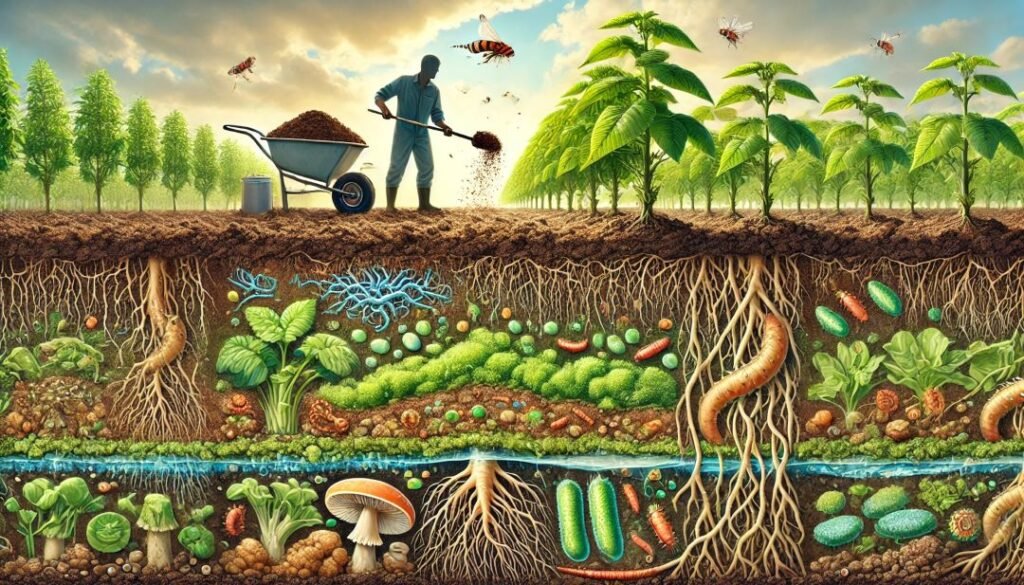Highlights
- The Role of Microbes in Soil Fertility
- How to Improve Soil Health Naturally
- Best Microbes for Soil Health in table
- How Microbial Farming Boosts Crop Yield
- Healthy Soil Indicators: What to Look For
- The Future of Soil Health: Biofertilizers for Sustainable Farming
Soil health improvement is the foundation of sustainable agriculture, and microbial farming techniques are revolutionizing the way we nurture our soils. By harnessing the power of beneficial microbes in soil, farmers can enhance soil fertility, increase crop yields, and promote regenerative soil health. In this blog, I’ll explore how microbial inoculants for soil work, the role of microbes in soil fertility, and organic ways to enhance soil microbes for long-term agricultural success.
The Role of Microbes in Soil Fertility
Microorganisms are the real heroes of healthy soil. They play a important role to break down organic matter, cycling nutrients, and improving soil structure. According to the USDA data, 1 gram of healthy soil contains up to 1 billion bacteria and 1 million fungi, all working together to support plant growth.
Key Functions of Soil Microbes:
- Nutrient Cycling: Soil microorganisms decompose organic substances to create essential nutrients namely nitrogen and phosphorus and potassium which help plants grow.
- Disease Suppression: The beneficial microorganisms in the soil use competition to overcome harmful pathogens which helps minimize the requirement for chemical pesticides.
- Soil Structure Improvement: Healthy microbes in the soil produce sticky compounds to unite particles which creates better water retention ability and better aeration.

How to Improve Soil Health Naturally
Improving soil health doesn’t have to rely on synthetic fertilizers or chemicals. Here are some organic ways to enhance soil microbes and promote regenerative soil health:
1. Use Microbial Inoculants for Soil
The natural improvement of soil health depends heavily on microbial inoculants as one of the best available tools. Beneficial microbe concentrations present in these products boost biological activity within the soil when they are added to it. What MarketsandMarkets reports demonstrates that microbial inoculants will experience a 102% market expansion from 409 million in 2021 to 826 million in 2026 due to their rising use in sustainable agricultural practices.
What Are Microbial Inoculants?
The application of beneficial bacteria and fungi along with other microorganisms under the name microbial inoculants occurs on seeds and in soil. The inoculants establish symbiotic connections within the root zone (known as rhizosphere) to deliver better nutrients while defending against pathogens.
Types of Microbial Inoculants and Their Benefits
- Mycorrhizal Fungi
- Function: When fungi create hyphal networks, they increase root structure length that provides plants better access to water sources and phosphorus nutrients.
- Impact: The implementation of mycorrhizal fungi leads to phosphate absorption improvements reaching 80% thus resulting in stronger more robust plant growth.
- Example: Glomus species serve as agricultural inoculants for growing corn soybeans as well as tomatoes in agricultural fields.
- Rhizobia Bacteria
- Function: The biological function of these bacteria creates nodules which develop on legume plant roots while converting airborne nitrogen into usable plant forms.
- Impact: Rhizobia bacteria constitute annual nitrogen fixation at 200-300 kg per hectare which substitutes the requirement of artificial nitrogen fertilizer use.
- Example: The agriculture industry commonly employs Rhizobium leguminosarum to support the growth of lentils and chickpeas among others.
- Phosphate-Solubilizing Bacteria (PSB)
- Function: The microbial organisms decompose soil-based insoluble phosphate materials into plant-accessible phosphorus.
- Impact: The application of PSB bacteria results in a 20-30% improvement of soil phosphorus availability thus leading to enhanced crop yield production.
- Example: Bacillus megaterium and Pseudomonas fluorescens serve as well-known strains of PSB.
- Plant Growth-Promoting Rhizobacteria (PGPR)
- Function: PGPR bacteria release auxins as well as gibberellins while also improving plant roots to better withstand stressful growing conditions.
- Impact: The scientific evidence demonstrates that PGPR applications lead to a minimum 10-20% yield increase and decrease chemical product requirements for farmers in agriculture.
- Example: The species Azospirillum functions extensively as a biological beneficial strain to support wheat and rice cultivation.

How to Apply Microbial Inoculants
- Seed Treatment: Soil Treatment Inoculants must be added to seeds through a coating process that lets roots become colonized early.
- Soil Application: Farmland Inoculants require mixing into soiling while planting or getting delivered through liquid solution application.
- Foliar Spray: Foliar Spray represents a method which allows some inoculants to be applied as sprays directly on plant leaves for fast absorption.
Real-World Success Stories
- The research team at University of California, Davis observed that inoculating tomatoes with mycorrhizal organisms elevated harvest results by 25% alongside a 30% reduction in freshwater requirements.
- Farmers in India who applied rhizobia inoculants to their soybeans achieved both higher yields by 15-20% and lowered their nitrogen fertilizer spending by 40%.
2. Practice Crop Rotation and Cover Cropping
Diversified soil microbiome occurs through crop rotations combined with cover crops that include clover or rye which helps prevent nutrient depletion.
3. Add Organic Matter
Soil microbes develop through compost and manure and plant residues which enhance both structure and fertility of the soil.
Best Microbes for Soil Health in table
Not all microbes are created equal. Here are some of the best microbes for soil health and their specific benefits:
| Microbe Type | Function | Example |
|---|---|---|
| Nitrogen-Fixing Bacteria | Convert atmospheric nitrogen into plant-available forms | Rhizobia, Azotobacter |
| Phosphate-Solubilizing Microbes | Release phosphorus from soil minerals | Bacillus, Pseudomonas |
| Mycorrhizal Fungi | Extend root systems for better nutrient uptake | Glomus species |
| Decomposers | Break down organic matter into humus | Actinobacteria, Fungi |

How Microbial Farming Boosts Crop Yield
The proof shows that using microbial farming methods creates higher crop production outputs and leads to decreased operating expenses. A research conducted by the Rodale Institute demonstrated farms using regenerative practices with microbial inoculants achieved 30% higher crop yield enhancements compared to conventional agricultural practices.
Benefits of Microbial Farming:
- Enhanced Nutrient Availability: The use of microbes improves plant access to nutritional elements.
- Improved Plant Immunity: The application of beneficial microbes helps enhance plant immunity and protect them from diseases. These microbes strengthen plant defenses.
- Reduced Environmental Impact: The use of microorganisms in farming reduces farmers’ dependence on synthetic chemicals thus preserving the environment sustainably.
Healthy Soil Indicators: What to Look For
A method to identify whether your soil maintains a healthy state exists. Here are some key indicators:
- Rich, Dark Color: Indicates high organic matter content.
- Good Soil Structure: The soil exhibits good structure when it forms small crumbs which maintain shape while remaining uncompacted.
- Abundant Earthworms: A sign of active microbial life.
- Optimal pH Levels: Soil quality allows most plants to grow best when its pH stays within the range of 6.0 to 7.5.
The Future of Soil Health: Biofertilizers for Sustainable Farming
Biofertilizers present a new solution to agricultural sustainability as the market demand increases. The products made with beneficial microbes present an environmentally friendly solution to chemical fertilizers. Research by Grand View Research shows that the global biofertilizers market will expand to $3.9 billion during the period from 2027.
Conclusion
Soil health improvement stands as a necessary practice because it represents the fundamental requirement for farming development toward the future. Farmers who adopt microbial farming methods obtain multiple benefits from soil-based beneficial microbes which simultaneously increase land fertility and production yields while creating conditions for soil regeneration. The essential principle is to align with nature’s methods in all agricultural practices including the use of microbial inoculants and organic methods.
